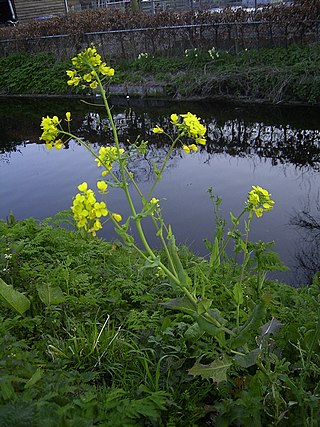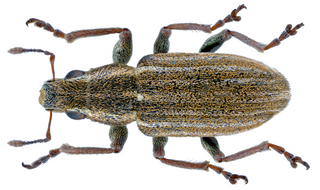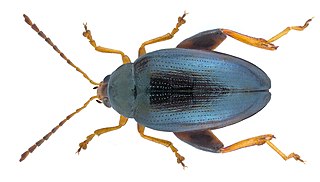
Brassica is a genus of plants in the cabbage and mustard family (Brassicaceae). The members of the genus are informally known as cruciferous vegetables, cabbages, or mustard plants. Crops from this genus are sometimes called cole crops—derived from the Latin caulis, denoting the stem or stalk of a plant.

Rapeseed, also known as oilseed rape, is a bright-yellow flowering member of the family Brassicaceae, cultivated mainly for its oil-rich seed, which naturally contains appreciable amounts of erucic acid. The term "canola" denotes a group of rapeseed cultivars that were bred to have very low levels of erucic acid and which are especially prized for use as human and animal food. Rapeseed is the third-largest source of vegetable oil and the second-largest source of protein meal in the world.

Aleochara is a genus in the beetle family Staphylinidae, the rove beetles. Larvae of Staphylinidae occur in many assorted ecological roles, most being scavengers, predators or carrion feeders, but the larvae of at least those species of Aleochara whose life histories are known are parasitoids. They feed in the puparia of suitable species of flies, killing the host in the process. Adult Aleochara are predators.

Delia flies are members of the Anthomyiidae family within the superfamily Muscoidae. The identification of different species of Delia can be very difficult for non-specialists as the diagnostic characteristics used for immature and/or female specimens may be inconsistent between species. Past taxonomic keys were not as comprehensive in their identification of Delia specimens; they were either too reliant on genetic characteristics, focused solely on a specific life stage, or were focused only on certain species. However current taxonomic keys aim to be more thorough by not only including morphological diagnostics for males, females, and immature specimens of various species, but also their genetic make-up or molecular barcode.

Anthonomus eugenii is known as the pepper weevil. This beetle feeds and lays eggs on plants in the genus Capsicum and a few species in the genus Solanum. A. eugenii is native to Mexico, however, it is an important pest of Capsicum in Florida, Puerto Rico, and Central America.

Diplotaxis tenuifolia is a species of flowering plant in the mustard family known by the common name perennial wall-rocket. It is native to Europe and western Asia, where it grows on disturbed ground and roadsides, and it can now be found throughout much of the temperate world where it has naturalized. In recent years it has increasingly been cultivated to produce salad leaves, which are marketed as wild rocket in Britain or arugula in the US. It is easily confused with garden rocket, which has similar uses.

Baridinae is a subfamily of true weevils (Curculionidae). It was established by Carl Johan Schönherr in 1836. Some 4,300 species in 550 genera are placed here, most of which occur in the New World. A few are economically significant pests, while others are in turn used for biocontrol of invasive plant pests. This subfamily also contains a few endangered species.

The maize weevil, known in the United States as the greater rice weevil, is a species of beetle in the family Curculionidae. It can be found in numerous tropical areas around the world, and in the United States, and is a major pest of maize. This species attacks both standing crops and stored cereal products, including wheat, rice, sorghum, oats, barley, rye, buckwheat, peas, and cottonseed. The maize weevil also infests other types of stored, processed cereal products such as pasta, cassava, and various coarse, milled grains. It has even been known to attack fruit while in storage, such as apples.

Sternochetus mangiferae is a weevil commonly known as the mango seed weevil, mango stone weevil, or mango weevil. It is a compact weevil typical of the Cryptorhynchinae. It was first described in 1775 in the genus Curculio. The adults are 7.5-9.5 mm long and 4 mm in width.
Alternaria black spot of canola or grey leaf spot is an ascomycete fungal disease caused by a group of pathogens including: Alternaria brassicae, A. alternata and A. raphani. This pathogen is characterized by dark, sunken lesions of various size on all parts of the plant, including the leaves, stem, and pods. Its primary economic host is canola. In its early stages it only affects the plants slightly by reducing photosynthesis, however as the plant matures it can cause damage to the seeds and more, reducing oil yield as well.

Acanthoscelides obtectus, the bean weevil, is a species of bruchid beetle. The species was described in 1831 by Thomas Say.

Hypera postica, commonly known as the alfalfa weevil, is a species of beetle in the superfamily Curculionoidea; it can be found in alfalfa fields throughout Europe. Considered a destructive threat to alfalfa production in North America, several accidental introductions have been successfully countered though the use of a variety of biological control species.

Sitona lineatus, commonly known as the pea leaf weevil is a species of weevil with a Palearctic distribution. It is a common pest of beans, peas, and other plants in the family Fabaceae. Adult beetles of S. lineatus measure 3.4-5.3 mm in length. They are characterized by a series of colored scales arranged in alternating lines (striae) on the elytra; it is from this characteristic where the species gets its name lineatus meaning 'lined' or 'striped'. The head and pronotum also have fine pointed setae amongst the scales. The antennae are clubbed, pointed and preceded by 7 segments. The femora is dark, but tibiae and tarsi are red. As a member of Order Coleoptera (beetles) their forewings are modified to form hardened covers over the thorax and abdomen, with the hindwings for flight underneath.

Psylliodes chrysocephala or Psylliodes chrysocephalus, commonly known as the cabbage-stem flea beetle, is a species of leaf beetle situated in the subfamily Galerucinae and the tribe Alticini.

Naupactus leucoloma is a species of broad-nosed weevil in the beetle family Curculionidae.

Bruchus pisorum, known generally as pea weevil, is a species of leaf beetle in the family Chrysomelidae. Other common names include the pea beetle and pea seed beetle. It is found in Europe and Northern Asia, North America, and temperate Asia.
Listronotus oregonensis, the carrot weevil, is a species of weevil in the beetle family Curculionidae. It is found in North America.
Cylindrocopturus adspersus, the sunflower stem weevil, is a species of true weevil in the beetle family Curculionidae. It is found in North America, where the larvae tunnel in the stems of wild and cultivated sunflower plants.
Ceutorhynchus rapae, the cabbage curculio, is a species of minute seed weevil in the beetle family Curculionidae. It is found in North America and Europe. It feeds on Erysimum crepidifolium, Erysimum cheiranthoides, and Capsella bursa-pastoris.
Myllocerus viridanus, often known as sweet potato beetle, pod borer or ash weevil, is a species of weevil native to India and Sri Lanka.















